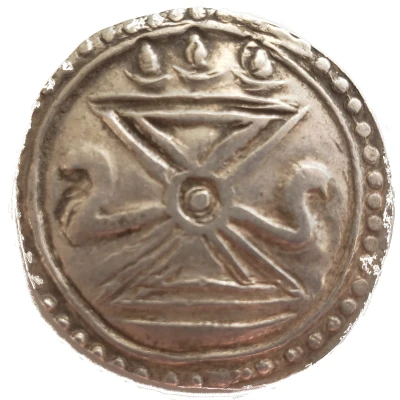


© Micheal Linke
96 Ratti Sriksetra-Hailin
| Silver (.970) | 10.25 g | 30 mm |
| Issuer | City of Halin (Pyu city-states) |
|---|---|
| Type | Standard circulation coin |
| Years | 400-600 |
| Value | 96 Ratti |
| Currency | Ratti |
| Composition | Silver (.970) |
| Weight | 10.25 g |
| Diameter | 30 mm |
| Shape | Round (irregular) |
| Technique | Hammered |
| Orientation | Medal alignment ↑↑ |
| Demonetized | Yes |
| Updated | 2024-10-10 |
| Numista | N#259078 |
|---|---|
| Rarity index | 92% |
Reverse
The reverse of the coin bears the srivatsa, an auspicious mark embodying good fortune. In its center is a sankha or conch shell.
Comment
The srivatsa on the reverse of this series bears a conch shell motif, which was often imitated by neighboring city states of the period. This first series was issued in denominations of 24 ratti, 48 ratti, 64 ratti, and 96 ratti. The designs were identical with several minor variations in the motifs. The Hailin derivative issues were issued in only two denominations, 64 ratti and 96 ratti.The silver purity of the Sriksetra and Hailin coins is very close to those found in the earlier rising sun type, usually around 97% silver purity balanced with copper. Lower purities may have had 93% silver.
Interesting fact
One interesting fact about this coin is that it was used as a form of currency in the Pyu city-states, which were a group of ancient cities located in present-day Myanmar (Burma) that flourished from the 2nd century BCE to the 10th century CE. The Pyu city-states were known for their advanced urban planning, architecture, and trade networks, and this coin is a testament to their advanced economic systems.